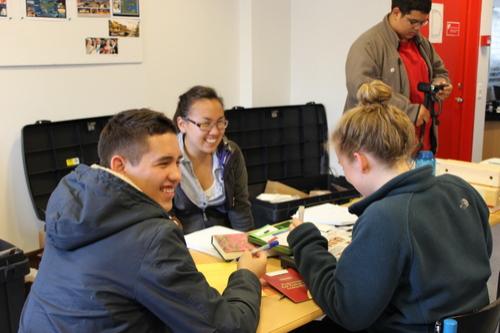After yesterday’s hike out to Russell GlacierA mass of ice that persists for many years and notably deforms and flows under the influence of gravity., I woke to aching arms and sore legs. Crawling out of bed was a challenge, but finding out that we were working with flowers was enough to add a hop to my step. Christine M. Urbanowicz from Dartmouth College visited us in the classroom – the plant lady. She called for a volunteer to draw the anatomy of a plant on the whiteboard, and Victor, our courageous volunteer, answered the call of duty.

Afterwards, we hiked down to Watson River and found patches of Niviarsiaq, pretty purple flowers, and the national flower of Greenland. Christine and her group of collegiate researchers had many plots like that from Kangerlussuaq to the ice sheet near Point 660. She was trying to find out how global warming might affect plant pollination. Her hypothesis was that global warming might increase the number of pollinator species like bees, flies, and stupid, annoying mosquitoes. She needed our help for her experiment. Christine’s experiment had three distinct parts. First, we manually pollinated the niviarsiaq by rubbing the stamen with pollen. Second, we bagged other niviarsiaq to stop pollination entirely. Last, we had a control variable where we rubbed some other niviarsiaq with paintbrushes to simulate pollination.
After lunch, we examined the rock samples that we acquired from Russell GlacierA mass of ice that persists for many years and notably deforms and flows under the influence of gravity. and around the area. Some of the rocks we found were anfibolite with garnets and gneiss. Needless to say, Rikke, our resident rock specialist and Greenlandic teacher, was extremely excited. Later, Lynn called us back to the classroom to discuss mathematical modeling. It is useful because it applies math to different situations by using a general equation to simulate them. She wanted us to measure the water discharge from the Watson River in cubic meters per second. The whole JSEP group collaborated on different ways to model that. Even Bo brought out his inner physics PhD to give a complicated model.
We, the mighty Umimmak group, were the first ones to conduct the experiment. We tied a bottle of sand to a rope which we lowered into the river from the bridge. We measured the length of the rope after five seconds of contact with the water. Using the Pythagorean Theorem, we calculated the velocity of the water. Once we got back inside, we multiplied the velocity with the area of the river and found out that the Watson River discharged about 399.032 cubic meters of water per second. At that rate (on an average summer day), it would empty an Olympic sized pool every 6.3 seconds. That is quite a lot of water.
Football (the international version, not the American wimpy version) is the national sport of Greenland. To conclude a day of researching flowers and calculating the velocity of the roaring Watson River water, a group of my Danish and Greenlandic friends and I played football on the local pitch. It is interesting to see how a game like football or a topic like science can bring together people of different cultures and ideas. Tomorrow is our free day, and hopefully, my friends and I will go hiking to make new memories (and hopefully spot some umimmat!)


Comments